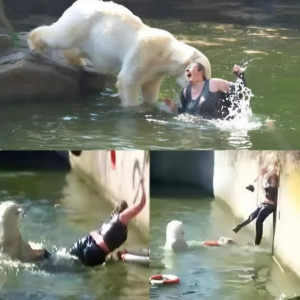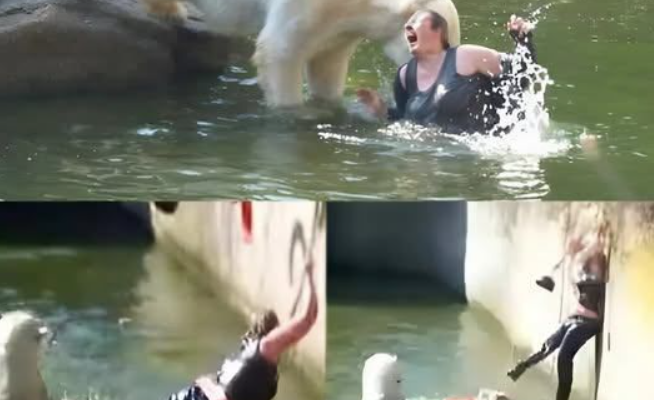Into the Ice: The Berlin Zoo Polar Bear Incident
On a crisp spring day in April 2009, Berlin Zoo was bustling with families, tourists, and animal lovers eager to catch a glimpse of its famed polar bears. The bears—massive, majestic, and notoriously dangerous—were the star attraction, especially during feeding time. But what began as a routine visit turned into a harrowing spectacle when a 32-year-old woman inexplicably climbed over the enclosure wall and plunged into the moat surrounding the polar bear habitat.
The Jump
It was Good Friday, just days before Easter, and the zoo was packed. The polar bear enclosure, designed with a three-foot perimeter wall and a deep moat, was considered secure. Yet, in a moment of inexplicable recklessness, the woman scaled the barrier and jumped into the icy water below. Witnesses described hearing a loud splash followed by gasps and screams as the woman began swimming toward the bears perched on a rocky island in the center of the enclosure.
Her motives remain unclear. Some speculated she was mentally unstable, others believed she was attempting a stunt. Regardless, her actions defied logic and safety. Polar bears are apex predators, capable of killing with a single swipe. Even zookeepers avoid entering the enclosure during feeding time, which was precisely when the woman made her move.
The Attack
Initially, the bears were distracted by their meal. But one bear noticed the intruder and approached. What followed was a terrifying sequence captured in photographs and witnessed by stunned onlookers. The bear lunged, biting the woman on the back of her neck. Her face contorted in pain as she struggled to escape. The bear pulled her back into the water, its powerful jaws clamping down as zookeepers scrambled to intervene.
Children screamed. Parents shielded their eyes. The scene was surreal—like something out of a horror movie. The woman, now bleeding and panicked, tried to swim away, but the bear pursued her. Zookeepers threw distractions, used poles, and eventually managed to pull her to safety. She was rushed to the hospital with severe injuries but survived—a miracle given the circumstances.
Public Reaction
The incident sparked immediate outrage and disbelief. How could someone breach the enclosure so easily? Why would anyone willingly enter a habitat housing one of the world’s most dangerous animals?
Zoo officials defended the enclosure’s design, noting that it met international safety standards. They emphasized that the woman had deliberately bypassed multiple barriers. Still, the event prompted a review of security protocols and raised questions about mental health, public safety, and the responsibilities of zoos in preventing such incidents.
Visitors expressed a mix of horror and sympathy. “It was the most terrifying thing I’ve ever seen,” said one witness. “She was so close to death. I still can’t believe she survived.” Others criticized the woman’s recklessness, arguing that her actions endangered not only herself but also the animals and staff.
Legal and Ethical Questions
Legally, the woman faced no charges. Her injuries were deemed punishment enough. But the incident reignited debates about liability and ethics. Should zoos be held accountable for breaches, even when caused by deliberate trespassing? Should individuals be prosecuted for endangering themselves and others?
Animal rights activists weighed in, concerned about the stress inflicted on the bears. “These animals are already living in captivity,” one activist noted. “Now they’re being provoked and punished for behaving naturally.” Fortunately, the bear involved was not harmed or relocated, but the incident served as a cautionary tale about human-animal boundaries.
Media Coverage and Sensationalism
The story made international headlines. Tabloids dubbed it “The Polar Bear Mauling,” while news outlets dissected every angle—from enclosure design to the woman’s psychological profile. Videos of the attack circulated online, drawing millions of views and sparking debates about voyeurism and ethics in media coverage.
Some criticized the sensationalism, arguing that the focus should be on prevention and education rather than spectacle. Others saw the incident as a wake-up call—a vivid reminder of nature’s power and the importance of respecting wildlife.
Psychological Dimensions
Though the woman’s identity was not widely disclosed, reports suggested she may have been suffering from mental health issues. Her decision to jump into the enclosure defied rational behavior, and experts speculated about possible delusions or suicidal intent.
This raised broader questions about mental health awareness and support. How do public spaces like zoos prepare for unpredictable human behavior? Should there be more visible security or mental health interventions in crowded venues?
Lessons Learned
The Berlin Zoo incident is more than a bizarre news story—it’s a case study in human behavior, safety design, and the unpredictable nature of wildlife. It underscores several key lessons:
- Respect for Boundaries: Wild animals, even in captivity, are not pets. They retain their instincts and can be deadly.
- Mental Health Awareness: Public spaces must be equipped to handle crises, including those stemming from psychological distress.
- Zoo Safety Protocols: While the enclosure met standards, the incident prompted a reevaluation of barriers, signage, and surveillance.
- Media Responsibility: Coverage should inform and educate, not exploit trauma for clicks and ratings.
Broader Implications
This event also touches on philosophical questions about human curiosity and risk. What drives someone to confront danger head-on? Is it thrill-seeking, desperation, or something deeper?
In literature and history, humans have always tested boundaries—from Icarus flying too close to the sun to explorers venturing into the unknown. The Berlin Zoo incident is a modern echo of that impulse—a reminder that curiosity, when unchecked, can lead to catastrophe.
Conclusion
The woman who entered the polar bear enclosure at Berlin Zoo survived a near-death experience that captivated the world. Her story is one of recklessness, resilience, and reflection. It challenges us to think about safety, empathy, and the fragile line between civilization and nature.
As zoos continue to evolve, incorporating more naturalistic habitats and interactive experiences, the need for vigilance grows. Visitors must understand that these spaces, while educational and entertaining, house creatures whose instincts cannot be tamed. And society must ensure that those struggling with mental health receive the support they need—before tragedy strikes.

